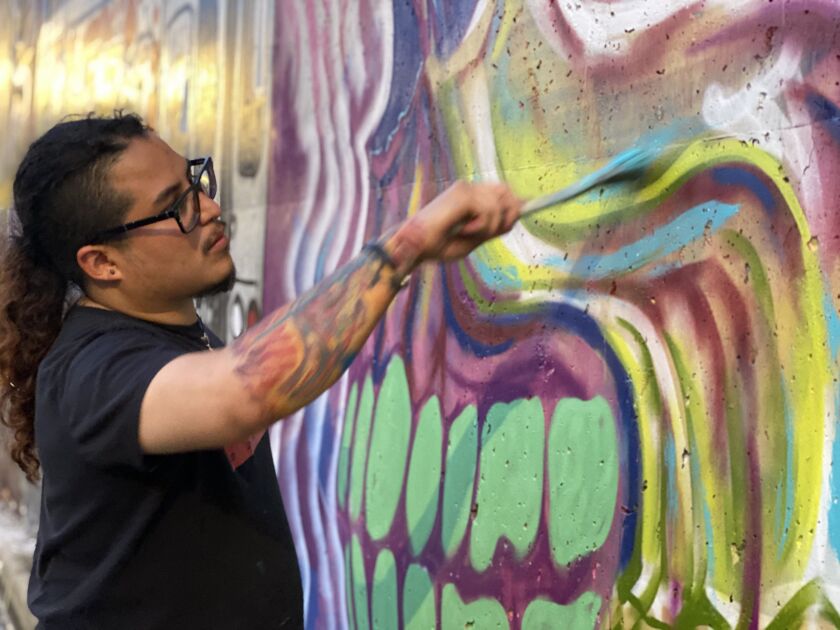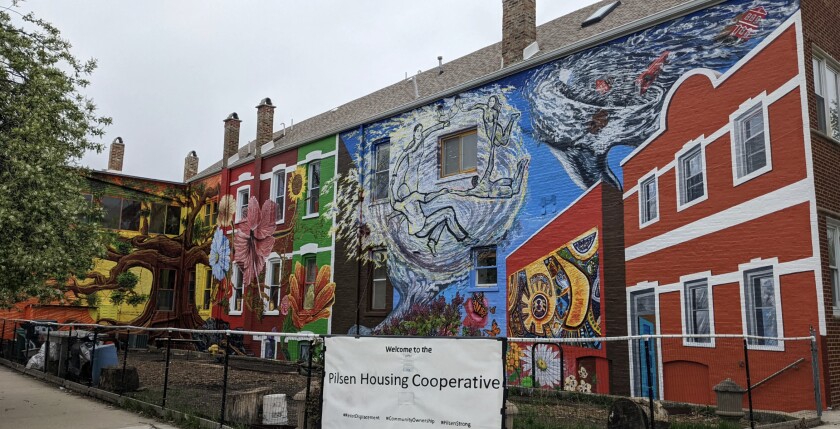At first sight, the mural on the side of a house in Pilsen is a little unnerving, with skeletons riding on the backs of stampeding, blood-red bulls.
But look more closely, and you’ll see the skeletons are carrying poles with flying banners that bear words conveying a decidedly different vibe.
One says “familia,” Spanish for family. Another says “comunidad,” community. And a third banner reads, “See Red.”
Which basketball fans might recognize as a slogan associated with the Bulls.
The mural, which blankets a home at 19th Street and Wolcott Avenue, was completed earlier this month in a partnership between a youth arts program called Yollocalli, and the Bulls. It’s meant to promote the NBA team and celebrate Latino heritage.
The banners are “a metaphor for achievement and for what’s important,” says Yollocalli’s Mario Mena, the lead artist on the project.
Mena says there’s also a tie-in to the giant flags that sometimes are waved at Bulls games by mascot Benny the Bull.
The stampeding creatures were inspired by the “Running of the Bulls” video that’s played before Bulls games.
The skeletons were inspired by the Day of the Dead holiday that’s important in Mexican culture, when friends and family who’ve died are remembered.
“The general design of the skeletons riding the bulls was inspired by” Mexican artist David Alfaro Siqueiros, Mena says. “He used a lot of death to convey a lot of social happenings at the time.”
A communist revolutionary who died in 1974, Siqueiros created a Depression-era mural titled “América tropical” that “challenged Los Angeles’s sanitized history of its Mexican past and the persecution of the city’s immigrant working class,” according to the University of California Press. “The establishment responded by requesting that Siqueiros leave the country and by whitewashing the mural.”
Mena, who completed the Pilsen mural with 15 teenagers in his street art class, says of Siqueiros, “I feel like him being one of the original people to paint on a wall is just very inspiring.
“He was was one of the original muralists that put murals in the United States” and he “paved the way” for today’s street artists, Mena says.
On the front of the Pilsen building, which is used as a guest house by the National Museum of Mexican Art that oversees Yollocalli, there’s also an image of Quetzalcoatl, a Toltec and Aztec god.
Resembling a dragon, its body wraps around the building and serves as kind of a backdrop to the rest of the mural, which is one of several within a single block.
One of the best known, at Wolcott Avenue and Cullerton Street, is at artist Hector Duarte’s home. It features a mural he painted about 20 years ago of a man described as a Latino Gulliver.
Across from Mena’s creation is another mural by Duarte and artist Gabriel Villa on a building at 1910 S. Wolcott Ave. that’s owned by the Pilsen Housing Cooperative. It features images of tornadoes, one of them shown destroying elements of traditional Mexican culture.
“It’s an honor to share space on that corner with someone of that caliber,” Mena says, noting that Duarte’s work also can be seen at the nearby National Museum of Mexican Art.
Duarte visited Mena and the students while they were painting and offered encouragement and pointers.
“Little by little, the whole street is coming along,” Duarte says. “We have almost a corridor. I like it.”











